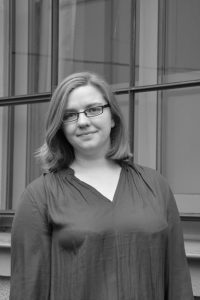Bianka Trötschel-Daniels

Shortbio
- geb. 1987 in Eisenach
- 2003 / Realschulabschluss
- 2003 / Stipendiatin des Deutschen Bundestages im Rahmen des Parlamentarischen Patenschaftsprogrammes
- 2006 / Abitur
- 2006–2011 / Studium der Rechtswissenschaften, Universität Osnabrück; Abschluss des Studiums mit der ersten juristischen Prüfung
- 2007–2011 / Stipendiatin der Konrad-Adenauer-Stiftung
- 2012–2014 / Fachmasterstudium der Geschichte, Universität Osnabrück
- 01.2012–09.2015 / wiss. Mitarbeiterin bei Professorin Dr. Pascale Cancik, Universität Osnabrück
- 05.2015–01.2017 / wiss. Mitarbeiterin, TU Dortmund, Forschungsprojekt „Welche Denkmale welcher Moderne?“ bei Professor Dr. Wolfgang Sonne, Projektleiterin im Teilprojekt B.1. Ingrid Scheurmann
- 2015 / Lehrbeauftragte an der Hochschule Osnabrück
Contact
Bauhaus-Universität Weimar
Fakultät Architektur und Urbanistik
DFG-Graduiertenkolleg 2227 “Identität und Erbe”
D-99421 Weimar
Sitz: Amalienstr. 13
D-99421 Weimar
bianka.troetschel-daniels[at]uni-weimar.de
The monument preservation law of the GDR from 1975 – Emergence and peculiarities in the international context.
The legal history of the GDR, especially the history of administrative law, is still little researched. Using the example of monument preservation law as a multi-layered part of active heritage preservation in the GDR, my thesis aims to contribute to the reappraisal of the law in the GDR. The dissertation focuses on the drafting of the GDR’s law on the preservation of historical monuments, which was passed in 1975. The legislative process in the GDR takes place during an eventful time for cultural heritage throughout Europe. The integration of the drafting process of the law into at least a European context is examined. A central thesis of the thesis is that the protection of monuments was used as a vehicle for international recognition and thus for the formation of the identity of the GDR as a state. Furthermore, through the regulatory object of “heritage,” attempts were made to use monuments to create identity for citizens, in the rhetoric of the GDR: “consciousness-raising.” The threshold of perception is low when it comes to preserving and maintaining the architectural, architectural-cultural heritage. Architecture forms the “material backbone of society and constitutes an essential identification factor.” [ 1 ] The practice of the care and preservation of building-cultural heritage in the GDR, in short: monument preservation, therefore provides impressive information about the heritage policy and the appropriation mechanisms to the cultural heritage over the decades.
Law offers society orientation. It regulates the “external coexistence of people” and not merely as a non-binding offer, but with a “normative claim that aims at compliance”. [ 2 ] It can be questioned as a historical source in many ways: Where did the inspiration for the texts come from, who was involved in their formulation, were there related texts abroad or unique features, are social developments reflected in different regulations at different times, did law have any effect at all and if so, how? Last but not least, one can ask about the image of the citizen of the state enacting the law; conversely, one can also ask about the self-image of the state in the European and international structure.
These legal and legal-historical questions are discussed in my work in an interdisciplinary way with cultural-political and cultural-historical questions. In the field of monument preservation, political guidelines from cultural and building policy come together, but also the departments of finance and foreign affairs were involved in the decision-making processes in monument preservation at the political level. On the one hand, the political guidelines were implemented at the specialist level by art historians and architects in the workplaces of the Institute for Monument Preservation. At the same time, there was a broad commitment to the monuments among the population through local history societies, in companies and social organizations. The question of the affirmation needs of communities and the appropriation of cultural heritage can therefore be studied particularly well in the preservation of monuments in the GDR.
[ 1 ] Engler, Harald/ Hasenöhrl, Ute/ Butter, Andreas, Architektur als Medium der Vergesellschaftung, in: Deutschlandarchiv vom 29.11.2012, online abrufbar unter: http://www.bpb.de/geschichte/zeitgeschichte/deutschlandarchiv/147718/architektur-als-medium-der-vergesellschaftung, letzter Abruf: 2.7.2016.
[ 2 ] Böckenförde, Ernst-Wolfgang, Vom Wandel des Menschenbildes im Recht, in: ders./ Gosewinkel, Dieter (Hrsg.), Wissenschaft, Politik, Verfassungsgericht, Berlin 2011, S. 13.
Publications
- Europäische Institutionenöffentlichkeit – Der Weg zur Mitgliedschaft der DDR bei Icomos (International Council on Monuments and Sites) 1964 bis 1969, in: Revue d’Allemagne (La République démocratique allemande dans l’espace public européen (1949-2018), Jg. 51, Heft 1/2019, S. 99–112.
- Rationelle Visionen – Raumproduktion in der DDR, hrsg. gemeinsam mit Tino Mager, Weimar 2019.
- Die Qual der (Aus-)Wahl. Zu den Auswahlkriterien in Archiv, Museum und in der Archäologie, in: Frank Eckardt/Hans-Rudolf Meier/Ingrid Scheurmann/Wolfgang Sonne (Hrsg.): Welche Denkmale welcher Moderne? Zum Umgang mit Bauten der 1960er und 70er Jahre, Berlin 2017, S. 102-113.
- BetonSalon – Neue Positionen zur Architektur der späten Moderne, hrsg. gemeinsam mit Tino Mager, Berlin 2017.
- Kann denn Beton Denkmal sein? – Zum Denkmalbegriff in der DDR, in: BetonSalon – Neue Positionen zur Architektur der späten Moderne, hrsg. gemeinsam mit Tino Mager, Berlin 2017, S. 127–138.
- Die Sozialistische Reichspartei (SRP) und die Wahl zum Zweiten Niedersächsischen Landtag (1951–1952), in: Dopke, Lisa et. al. (Hrsg.): Deutsche Kontinuitäten, Hannover 2016, S. 127–154.
Presentations and conference papers
- 19. März 2019: Denkmalpflege in der DDR mit Bezügen zu Eisenach, Förderkreis zur Erhaltung Eisenachs e.V. Veranstaltung
- 2018, Sep: The European Dimension of Monuments Preservation in the GDR (Die Europäische Dimension der Denkmalpflege in der DDR), Conference: La RDA dans l’espace public européen 1949–2018, Die DDR in der europäischen Öffentlichkeit 1949–2018, Strasbourg, Universität Strasbourg.
- 2016, Nov: The Heritage Council of the GDR, (Der Nationale Rat zur Pflege und Verbreitung des deutschen Kulturerbes in der DDR), Conference: Heritage Studies and Socialism: Transnational Perspectives on Heritage in Eastern and Central Europe, Gießen, Herder Institut for Historical Research on East Central Europe and international Graduate Centre for the Study of Culture (GCSC)